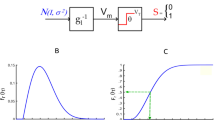Summary
Comparative recordings of short-latency somatosensory evoked potentials with midfrontal (Fz), ear and non-cephalic reference electrodes were obtained in 12 normal subjects to define the site of the generators of the different components and the spatial distribution and interference of the different components recorded at the neck and scalp. Such investigations provide the basis for identical investigations in patients with focal lesions of the central nervous system. The N 13 recorded from the neck (C 2-Fz) and the inconsistently recorded component N 14 were quite similar in latency to the far-field potentials P 13 and P 14 recorded at the scalp (C3′, C4′—ear or hand). The component P 15 was clearly visible only in scalp-Fz leads and occurred 0.2–0.9 ms (mean 0.5 ms) later than P 14 in ear or hand reference recordings. This is evidence against the identity of these two components proposed by others. In a larger group of 48 subjects, using an exclusive Fz-reference lead, normal values were established of the components P 15, P 16 and P 18, as well as their scalp distribution.
Zusammenfassung
An 48 Normalpersonen wurden die Normalwerte der spinalen und subkortikalen SEP-Komponenten (einschließlich P 16 und P 18) nach Medianus-Stimulation am Handgelenk ermittelt, wobei eine frontomediane Referenz (Fz) gewählt wurde. Bei einem Teil der Probanden (n=12) erfolgten zusätzliche Ableitungen der Reizantworten gegen eine Ohr- sowie eine extrakephale (Hand-) Referenz, um die Beziehungen der hierbei registrierbaren positiven „Far-field-Potentiale“ zu den einzelnen Komponenten des Nacken-SEP zu klären. Die von der oberen Nackenpartie (C 2-Fz) abgeleiteten Komponenten N 13 und N 14 stimmten in ihrer Latenz mit den von der Kopfhaut abgeleiteten Komponenten P 13 und P 14 überein, wobei ein Teil der Probanden anstelle zweier deutlich unterscheidbarer P 13- und P 14-Komponenten lediglich eine positive Potentialschwankung aufwies. Die bei frontomedianer Referenz konstant sichtbare P 15-Komponente wies bei allen Untersuchten eine 0,2–0,9 ms längere Latenz auf als das mit extrakephaler Referenz registrierte Far-field-Potential P 14, was gegen die von anderer Seite vermutete Identität dieser beiden Komponenten spricht. Die klare gegenseitige Abgrenzung der frühen somatosensiblen Reizantworten nach Medianusstimulation bei Wahl unterschiedlicher Referenzorte ist Voraussetzung für eine verfeinerte Lokalisationsdiagnostik innerhalb des lemniskalen Systems der Somatosensorik.
Similar content being viewed by others
References
Alajouanine TH, Scherrer J, Barbizet J, Calvet J, Verley J (1958) Potentiels évoqués corticaux chex des sujets atteints de troubles somésthésiques. Rev Neurol (Paris) 98:757
Allison T, Hume AL (1981) A comparative analysis of short-latency somatosensory evoked potentials in man, monkey, cat and rat. Exp Neurol 72:592–611
Allison T, Wood CC, McCarthy GM, Hume AL, Goff WR (1982) Short-latency somatosensory evoked potentials in man, monkey, cat and rat: comparative latency analysis. In: Courion J, Maugière F, Revol M (eds) Clinical applications of evoked potentials in neurology. Raven Press, New York
Anziska B, Cracco RQ (1980) Short latency somatosensory evoked potentials: studies in patients with focal neurological disease. Electroencephalogr Clin Neurophysiol 49:227–239
Anziska BJ, Cracco RQ (1981) Short latency SEPs to median nerve stimulation: comparison of recording methods and origin of components. Electroencephalogr Clin Neurophysiol 52:531–539
Bergamini L, Bergamasco B, Fra L, Gandiglio G, Mombelli AM, Mutani R (1965) Somatosensory evoked cortical potentials in subjects with peripheral nervous lesions. Electromyography 5:121
Chiappa KH, Choi SK, Young RR (1980) Short-latency somatosensory evoked potentials following median nerve stimulation in patients with neurological lesions. In: Desmedt JE (ed) Clinical uses of cerebral brainstem and spinal somatosensory evoked potentials. Karger, Basel, pp 264–281
Cracco RQ (1973) Spinal evoked response: peripheral nerve stimulation in man. Electroencephalogr Clin Neurophysiol 35:379–386
Cracco RQ, Cracco JB (1976) Somatosensory evoked potentials in man: far-field potentials. Electroencephalogr Clin Neurophysiol 41:460–466
Desmedt JE, Noel P (1973) Average cerebral evoked potentials in the evaluation of lesions of the sensory nerves and of the central somatosensory pathway. In: Desmedt JE (ed) New developments in electromyography and clinical neurophysiology, vol 2. Karger, Basel, pp 352–371
Desmedt JE, Cheron G (1980) Central somatosensory conduction in man: neural generators and interpeak latencies of the far-field components recorded from neck and right or left scalp and earlobes. Electroencephalogr Clin Neurophysiol 50:382–403
Desmedt JE, Cheron G (1981) Prevertebral (oesophageal) recording of subcortical somatosensory evoked potentials in man: the spinal P13 component and the dual nature of the spinal generators. Electroencephalogr Clin Neurophysiol 52:257–275
El-Negamy E, Sedgwick EM (1978) Properties of a spinal somatosensory evoked potential recorded in man. J Neurol Neurosurg Psychiatry 41:762–768
Giblin DR (1964) Somatosensory evoked potentials on healthy subjects and in patients with lesions of the nervous system. Ann NY Acad Sci 112:94–142
Halliday AM (1967) Changes in the form of cerebral evoked responses in man associated with various lesions of the nervous system. Electroencephalogr Clin Neurophysiol [Suppl] 25:178–192
Jones SJ, Halliday AM (1982) Subcortical and cortical somatosensory evoked potentials: characteristic waveform changes associated with disorders of the peripheral and central nervous system. In: Courjon J, Maugiere F, Revol M (eds) Clinical applications of evoked potentials in neurology. Raven, New York, pp 313–320
Small DG, Beauchamp M, Matthews WB (1980) Subcortical somatosensory evoked potentials in normal man and in patients with cerebral nervous system lesions. In: Desmedt JE (ed) Clinical uses of cerebral brainstem and spinal somatosensory evoked potentials. Karger, Basel, pp 190–204
Stöhr M, Dichgans J, Diener HC, Buettner UW (1982) Evozierte Potentiale. SEP-VEP-AEP. Springer, Berlin Heidelberg New York
Stöhr M, Buettner UW, Riffel B, Koletzki E: Spinal somatosensory evoked potentials in cervical cord lesions. Electroencephalogr Clin Neurophysiol (in press)
Yamada T, Kimura J, Nitz DM (1980) Short latency somatosensory evoked potentials following median nerve stimulation in man. Electroencephalogr Clin Neurophysiol 48:367–376
Author information
Authors and Affiliations
Rights and permissions
About this article
Cite this article
Stöhr, M., Riffel, B. short-latency somatosensory evoked potentials to median nerve stimulation: components N 13-P 13, N 14-P 14, P 15, P 16 and P 18 with different recording methods. J Neurol 228, 39–47 (1982). https://doi.org/10.1007/BF00313408
Received:
Issue Date:
DOI: https://doi.org/10.1007/BF00313408




